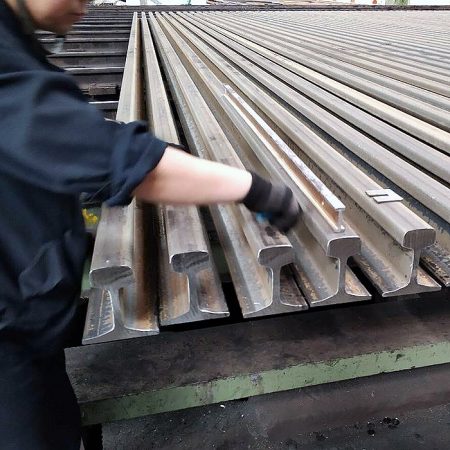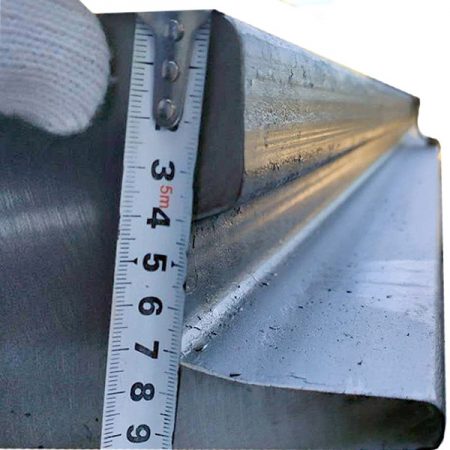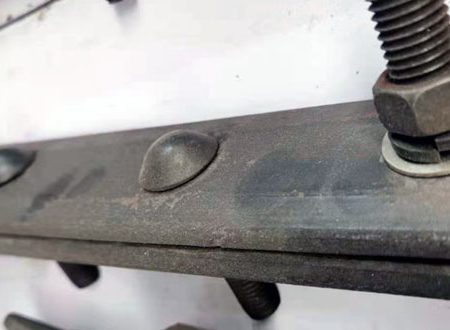Le rail en acier EN13674-4 45E1 est un type de rail standard européen fabriqué à partir d’acier de nuance 900A avec une résistance minimale à la traction de 900 N/mm2. Le rail a une largeur de tête de 66.67 mm, une hauteur de 142.88 mm et une largeur inférieure de 127 mm. The designation 45E1 refers to the rail’s weight in kilograms per meter. It is commonly used for railways line.
EN13674-4 45E1 steel rail can be used in areas with harsh weather conditions, such as extreme cold or heat, and in areas with high levels of corrosion and wear.
The production process of EN13674-4 45E1 steel rail typically includes the following steps:
1. Raw materials: Start with high-quality steel billets that meet the requirements of EN13674-4 standard.
2. Heating: Heat the steel billets in a reheat furnace to a temperature suitable for rolling and shaping.
3. Rolling: Hot-roll the billets into the desired shape, using a rolling mill. This process involves passing the heated billets through a series of rollers to form the rail shape.
4. Cooling: Allow the rail to cool slowly to room temperature in a cooling bed so that it can develop its strength and hardness.
5. Découpage: Cut the rail to the required length using a saw or guillotine.
6. End finishing: Finish the ends of the rail by cutting them at a specific angle to allow them to fit together seamlessly with other rails.
7. Contrôle qualité: Inspect the rails to ensure compliance with EN13674-4 standards, y compris la précision dimensionnelle, rectitude, Qualité de surface, et propriétés mécaniques.
8. Packaging and shipping: Package the rails according to customer requirements and ship them to the customer.
The production process may vary slightly depending on the specific manufacturing process and the requirements of the customer.
The 45E1 rail is a type of steel rail commonly used for heavy-duty industrial applications, such as railway tracks, Tramways, and subway lines. It is used in many countries around the world, including but not limited to China, les États-Unis, Europe, et l’Amérique du Sud. The use of this type of rail is dependent on the specific needs and requirements of the railway system or project where it will be applied.
Nous pouvons fournir toutes sortes de rails en acier standard chinois et d’autres types de rails standard internationaux, peut également fabriquer des rouleaux pour produire un type spécial de rail en acier si la quantité est suffisante. Nous pouvons également concevoir une ligne de chemin de fer selon vos besoins, et construire une ligne de chemin de fer minier et une ligne de déplacement de grue, et fournir les fixations exploitables.
Nous avions vendu des rails et des fixations en acier à l’Australie, Angleterre, Singapour, Malaisie, Indonésie, Kenya, Azerbaïdjan, Albanie, Pakistan, Turquie, Corée, Roumanie, Arabie Saoudite, Viêt Nam, Zimbabwe, Ghana and other countries.
Nous traitons avec des clients étrangers depuis longtemps, avoir des expériences riches pour résoudre n’importe quel problème, résoudre les problèmes de langage et de technologie, et réaliser vos produits requis comme vous le souhaitez.
Nous sommes heureux d’accepter votre lettre de crédit et votre inspection par un tiers, Vous ne vous soucierez jamais de la sécurité du paiement et de la qualité des produits. Au plaisir d’obtenir une bonne coopération à long terme avec vous à l’avenir.
Nous pouvons fournir les rails de fond plats standard internationaux comme ci-dessous, si vous en avez besoin, N’hésitez pas à nous demander:







